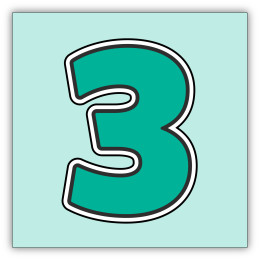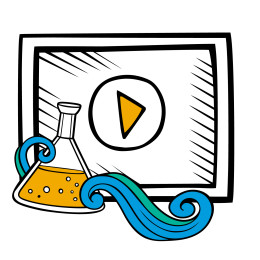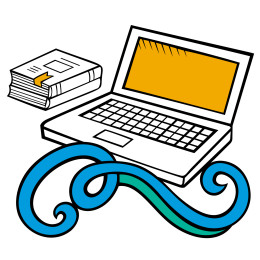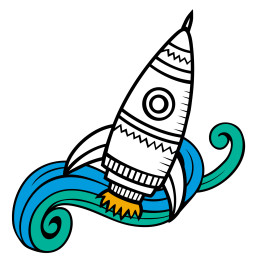
Follow these steps to get started!
There are lots of different ways to invent and innovate. The steps below are one way to begin your journey, but we encourage you to experiment and find the path that works best for you. There’s no “right” way to start. Always remember: Messing up is an important part of the process and failure is necessary in everything we do—that’s how we learn new things and come up with solutions!

IDENTIFY the problem
Every invention starts with a problem. Before you can create something new, you need to understand what’s wrong or what could be improved and made better.
Look around you. What frustrates you? What could you create, improve upon, or change to help others in their daily lives? You could improve something that takes too long, something that’s hard to use, or something that just doesn’t work as well as you think it could. The problem can be small and personal, like fixing a zipper that always gets stuck or keeping the items in your lunchbox from getting squished, or it can be something big that affects your whole community, like cleaning up plastic in the ocean or making recycling easier.
Here are some real-life examples of problems that led to amazing inventions:
In the early 1900s, Mary Anderson noticed that New York City streetcar drivers couldn’t keep their windshields clear in bad weather. These drivers often had to lean out the side windows to see where they were going. You can probably guess what she did next: invented the first effective windshield wiper device! Anderson was granted U.S. Patent No. 743,801 for her "Window cleaning device" on November 10, 1903.
When she was 11 years old, Gitanjali Rao was watching the news with her parents when she heard about the water crisis in Flint, Michigan. She couldn’t sleep that night knowing that kids just like her couldn’t access clean drinking water in their own homes. Determined to find a way to help, Gitanjali invented a device to quickly and accurately test water for contaminants. Read more about Gitanjali’s invention journey.
It’s really important to gather information from people who face the problem you want to solve. Listen to their experiences so that you can put yourself in their shoes and imagine solutions that would help them. Maybe you know a classmate whose shoelaces keep coming untied or an elderly grandparent who could use help getting out of a chair. Maybe you learn about something in the news that inspires you to try to help an entire community, like Gitanjali hearing about the Flint water crisis. Whatever it is, clearly understanding the problem is a crucial first step for your invention journey.

EXPLORE solutions
Once you identify the problem, it’s time to think about solutions. This is where you can let imagination run wild—there are no wrong answers in this step!
In this step, you’ll come up with as many different ideas to solve your problem as you can think of. This is called brainstorming. The most important thing to remember about brainstorming is that there are no bad ideas. Here are some tips to help you with this step:
Write down EVERY idea you can think of, even if it seems silly or impossible. Sometimes the wackiest ideas lead to the best inventions!
Everyone has a different perspective. Talk to friends, family, or classmates—they might see things from a different angle and help spark new ideas.
Research how similar problems have been solved in the past. Maybe your problem can be solved by combining two or more existing inventions in a new way, or maybe there’s a part of a current invention that you can repurpose. You can find every invention ever granted a U.S. patent with the USPTO’s Patent Search tool. Searching previous inventions is a critical part of the research process, and allows inventors to build upon others’ creations, improve and find new uses for them, or change them altogether. To help with your search check out a Patent and Trademark Resource Center (PTRC) near you.
The goal is to come up with as many ideas as possible. No matter how silly or out-there they might seem, ALL ideas are valuable. Once you have a list, go through it and start narrowing your ideas down until you can pick one to move forward with. Keep your list of brainstormed ideas! It might be useful later.

DESIGN and BUILD
Now that you’ve chosen your best idea, it’s time to make a plan. You’ll sketch out a design of what your invention might look like, identify the materials you’ll need, and figure out how to build it.
This step is where you turn your idea into a real invention. Often, inventors will build a prototype. A prototype is a model of the invention. It does not have to be the actual size or have all of the functionality. Prototypes help inventors figure out what works and what doesn’t before they start using valuable time and resources to build the real thing.
Start by sketching out your idea on paper or using a computer program. Label the important parts of the design and what their function is.
Think about the materials you’ll need and how each part will work together. Remember that a prototype can be a non-working representation of your idea. It doesn’t have to be life-size, and the materials might be different than the ones used in the final version of the invention. Recycled materials from home are great to use for building prototypes.
Once you have a design sketch and a list of materials—start building!
Don’t worry if your invention or prototype doesn’t work perfectly right away. Inventing takes time, and often things don’t go as planned... which brings us to the next step.

TEST, EVALUATE, and REDESIGN
After you’ve built your invention or a prototype of it, it’s time to test it out! See if it solves the problem, take notes on what did and didn’t work, and then improve it by making changes based on what you learned.
Testing is one of the most important parts of inventing. Does your invention work the way you expected? Does it fix the problem you set out to solve? Does it fix part of the problem but create other problems in the process? Be prepared to address all of these questions and expect the unexpected.
After each round of testing, figure out what could be better. You might need to experiment with different materials, change how the parts are connected to each other, or even go back to the brainstorming stage. Maybe one of the ideas you came up with that you didn’t use will come in handy.
Remember, if your invention doesn’t work perfectly the first time, that is okay. In fact, it’s even expected! Most inventions go through many, many rounds of changes before they’re complete. This process of testing and improving is called iteration. Keep iterating until your invention is just the way you want it.

PROTECT your intellectual property
Congratulations, your invention works perfectly! All set to share with the world, right? Not so fast! Your invention is a form of intellectual property, and you may want to consider protecting it with a patent if it meets certain requirements.
A patent is issued by the U.S. Patent and Trademark Office (USPTO). It gives you (the inventor) the right to exclude other people from making, using or selling your invention, offering your invention for sale, or importing your invention into the United States for a limited time. In exchange for this right, you agree to make public how your invention works. This way, the patent system enables the exchange of knowledge. Other inventors can build upon and improve what you created using the information in your patent application. By filing a patent application, you’re contributing to the ongoing process of scientific research and discovery. That’s pretty cool!
For example, to qualify for a utility patent, your invention must be new and useful to a person of ordinary skill in the field relating to your invention. Inventors of all ages can file for a patent. Inventors as young as five years old have successfully received patents for their inventions. Explore our Young Inventor Spotlights to learn more about the paths young inventors have taken to a patent.
If you decide you want to file a patent application, there are many resources available to help you. You can start on the USPTO’s Applying for patents page—don't be afraid to ask a parent, teacher, or mentor for help.
Other forms of intellectual property are trademarks (which we’ll discuss in the next step), copyright, and trade secrets. Learn more about patents and these other types of intellectual property protection on our Explore intellectual property page.

Prepare to SHARE your invention
Once you’re happy with your invention and it successfully solves the problem you set out to solve, it’s time to show it to the world! Before you do, you might want to think about the best way to advertise your creation to other people who could benefit from it—that’s where trademarks come in.
When you’re ready to share your invention with others, you’ll want to think about how you can make it stand out by creating a trademark. Trademarks help people know who makes or sells a product or service. In other words, trademarks identify the source of goods and services and distinguish it from other sources. A trademark can be words, designs, a cool symbol, or a combination of these.
Think of some of your favorite products—many of them have catchy names and logos that are immediately recognizable. The Nike® swoosh (along with their “Just do it!” slogan), the Apple® logo, and the McDonald’s® double golden arches are three examples. A strong trademark creates trust with your customers, which is why it’s such an important part of any business. Here are some quick tips to get you started creating a trademark for your invention:
Write down ten (or more!) words that will inspire people to think about what your invention does, what problem it solves, or any cool new features it has.
Using the words you came up with as a starting point, come up with three or four possible brand names for your invention. You can also make up a word or combine parts of words—just make sure it’s easy to pronounce. It should be short!
Draw a logo for your invention. Experiment with the three or four brand name possibilities and see which ones work better as a logo. You can stylize the letters, create an interesting background, and use color to generate an emotional response in people who see it.
What's next?
Jump into more ways to bring your ideas to life!

Videos and activities for grades K-12

Explore intellectual property (IP)



